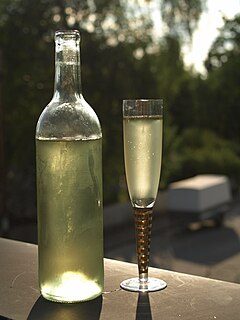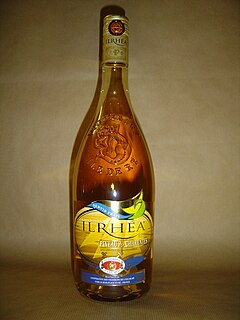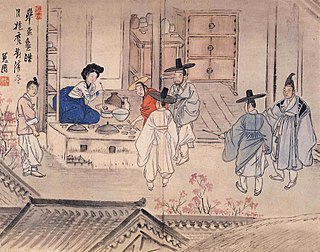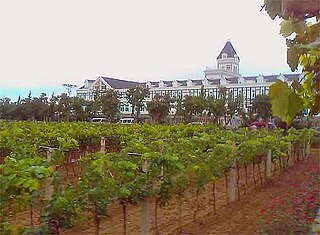This article needs additional citations for verification .(September 2017) |
Museles is a wine produced in Xinjiang, China. It is commonly made for local consumption, but is now also produced commercially for export outside the region. [1]
This article needs additional citations for verification .(September 2017) |
Museles is a wine produced in Xinjiang, China. It is commonly made for local consumption, but is now also produced commercially for export outside the region. [1]
China's Xinjiang Autonomous Region have an ancient history of viticulture going back to around the 4th century BC, when Greek settlers brought the vine and more advanced irrigation techniques. The area around Turfan was, and still is, particularly noted for its grape production, and its production of grape wines is mentioned in the historical record as well. Its wine was noted during the Tang dynasty, Marco Polo also mentioned that Carachoco (the name he used for Turfan) produced fine grape wines. The modern wine industry is largely patterned after French methods, with a concentration on varieties like Cabernet. However, the Uighur traditional technique has survived, especially in counties surrounding Kashgar.

The Uighur home-made wine generally called "museles" (from Arabic "المثلث", meaning "the triangle") is still being brewed by households in many villages. Unlike wines west of Xinjiang, the brewing of museles requires crushing of local varieties of grapes by hand, then strained using the Uighur atlas silk, then boiled with an amount of water equal to the juice and desired portion of sugar, until the volume of the mixture is down to the original volume of the juice, then stored in clay urns together with folk recipes varying by localities---in some counties, traditional Uighur herbal medicines, and goji, mulberries, sea-buckthorn, cloves, etc. in others, and even raw and unfeathered pheasants or poussins in others. The brew usually takes more than a month to accomplish. It is then un-urned, filtered and bottled to be stored for long periods. In some villages, the ritual of communally gathering a mixture of folk museles brews in a large village urn marks the occasion following the harvest and process of grapes.
Museles is now being standardized by the wine producing industry in China and marketed under the brand-name of Merceles.

A drink is a liquid intended for human consumption. In addition to their basic function of satisfying thirst, drinks play important roles in human culture. Common types of drinks include plain drinking water, milk, juice, smoothies and soft drinks. Traditionally warm beverages include coffee, tea, and hot chocolate. Caffeinated drinks that contain the stimulant caffeine have a long history.

Vinegar is an aqueous solution of acetic acid and trace compounds that may include flavorings. Vinegar typically contains 5–8% acetic acid by volume. Usually, the acetic acid is produced by a double fermentation, converting simple sugars to ethanol using yeast, and ethanol to acetic acid by acetic acid bacteria. Many types of vinegar are available, depending on source materials. It is now mainly used in the culinary arts as a flavorful, acidic cooking ingredient, or in pickling. Various types of vinegar are also used as condiments or garnishes, including balsamic vinegar and malt vinegar.

Wine is an alcoholic drink typically made from fermented grapes. Yeast consumes the sugar in the grapes and converts it to ethanol and carbon dioxide, releasing heat in the process. Different varieties of grapes and strains of yeasts are major factors in different styles of wine. These differences result from the complex interactions between the biochemical development of the grape, the reactions involved in fermentation, the grape's growing environment (terroir), and the wine production process. Many countries enact legal appellations intended to define styles and qualities of wine. These typically restrict the geographical origin and permitted varieties of grapes, as well as other aspects of wine production. Wines not made from grapes involve fermentation of other crops including rice wine and other fruit wines such as plum, cherry, pomegranate, currant and elderberry.

Mead is an alcoholic beverage made by fermenting honey mixed with water, and sometimes with added ingredients such as fruits, spices, grains, or hops. The alcoholic content ranges from about 3.5% ABV to more than 18%. The defining characteristic of mead is that the majority of the beverage's fermentable sugar is derived from honey. It may be still, carbonated, or naturally sparkling; dry, semi-sweet, or sweet.

Sparkling wine is a wine with significant levels of carbon dioxide in it, making it fizzy. While the phrase commonly refers to champagne, European Union countries legally reserve that term for products exclusively produced in the Champagne region of France. Sparkling wine is usually either white or rosé, but there are examples of red sparkling wines such as the Italian Brachetto, Bonarda and Lambrusco, and the Australian sparkling Shiraz. The sweetness of sparkling wine can range from very dry brut styles to sweeter doux varieties.
Pisco is a colorless or yellowish-to-amber colored brandy produced in winemaking regions of Peru and Chile. Made by distilling fermented grape juice into a high-proof spirit, it was developed by 16th-century Spanish settlers as an alternative to orujo, a pomace brandy that was being imported from Spain. It had the advantages of being produced from abundant domestically grown fruit and reducing the volume of alcoholic beverages transported to remote locations.

There is a long history of alcoholic drinks in China. They include rice and grape wine, beer, and various liquors including baijiu, the most-consumed distilled spirit in the world.

Carbonic maceration is a winemaking technique, often associated with the French wine region of Beaujolais, in which whole grapes are fermented in a carbon dioxide rich environment before crushing. Conventional alcoholic fermentation involves crushing the grapes to free the juice and pulp from the skin with yeast serving to convert sugar into ethanol. Carbonic maceration ferments most of the juice while it is still inside the grape, although grapes at the bottom of the vessel are crushed by gravity and undergo conventional fermentation. The resulting wine is fruity with very low tannins. It is ready to drink quickly but lacks the structure for long-term aging. In extreme cases such as Beaujolais nouveau, the period between picking and bottling can be less than six weeks.

A rosé is a type of wine that incorporates some of the color from the grape skins, but not enough to qualify it as a red wine. It may be the oldest known type of wine, as it is the most straightforward to make with the skin contact method. The pink color can range from a pale "onionskin" orange to a vivid near-purple, depending on the grape varieties used and winemaking techniques. Usually, the wine is labelled rosé in French, Portuguese, and English-speaking countries, rosado in Spanish, or rosato in Italian.

Pineau des Charentes, is a regional aperitif of western France, made in the départements of Charente, Charente-Maritime, and Dordogne. While popular within its region of production, it is less well known in other regions of France and somewhat uncommon abroad.

Korean cuisine has a wide variety of traditional alcoholic drinks, known as sul (술). Many of these drinks end with the Sino-Korean word -ju, and some end with the native Korean word -sul. The Sino-Korean -ju is not used as an independent noun.
The glossary of wine terms lists the definitions of many general terms used within the wine industry. For terms specific to viticulture, winemaking, grape varieties, and wine tasting, see the topic specific list in the "See also" section below.

Palatinate is a German wine-growing region (Weinbaugebiet) in the area of Bad Dürkheim, Neustadt an der Weinstraße, and Landau in Rhineland-Palatinate. Before 1993, it was known as Rhine Palatinate (Rheinpfalz). With 23,461 hectares under cultivation in 2008, the region is the second largest wine region in Germany after Rheinhessen. There are about 6,800 vintners producing around 6.5 million hectolitres of wine annually.

Uyghur cuisine is a cuisine of the Uyghur people, which is also consumed outside of Xinjiang. Signature ingredients include roasted mutton, kebabs, and rice. Because of the Muslim population, the food is predominantly halal.

Although viticulture and the cultivation of grapes for table consumption has a long history in Japan, domestic wine production using locally produced grapes only really began with the adoption of Western culture during the Meiji restoration in the second half of the 19th century.
Wine has a long history in China. Although long overshadowed by huangjiu and the much stronger distilled spirit baijiu, wine consumption has grown dramatically since the economic reforms of the 1980s. China is now numbered among the top ten global markets for wine. Ties with French producers are especially strong, and Ningxia wines have received international recognition.

Catalan wines are those that are produced in the wine region of Catalonia. Occasionally, the appellation is applied to some French wine made in the Catalan region of Roussillon also known as Northern Catalonia or the Pays catalans. The city of Barcelona is the capital of Catalonia and despite not being in a wine region it is the focal point of the Catalan wine industry: a primary consumer market, its port provides export functions and a source of financial resources and investment.

Ancient Rome played a pivotal role in the history of wine. The earliest influences on the viticulture of the Italian peninsula can be traced to ancient Greeks and the Etruscans. The rise of the Roman Empire saw both technological advances in and burgeoning awareness of winemaking, which spread to all parts of the empire. Rome's influence has had a profound effect on the histories of today's major winemaking regions in France, Germany, Italy, Portugal and Spain.

Changyu Pioneer Wine Co. Inc., located in Yantai, Shandong, is China's oldest and largest winery. It was founded in 1892 by Cheong Fatt Tze.

Huangjiu, meaning yellow wine, is a Chinese alcoholic beverage, and is most popular in the Jiangnan area. Huangjiu is brewed by mixing boiled grains including rice, glutinous rice or millet with qū as starter culture, followed by saccharification and fermentation at around 13-18 °C for fortnights. Its alcohol content is typically 8%-20%.